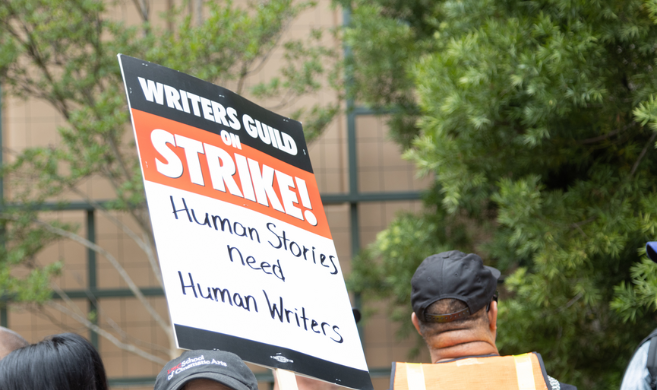What is the legal status of a cinematographic work?
As a matter of principle, Article L111-1 of the French Intellectual Property Code (CPI) does not define either the author or the work for historical and technical reasons, adopting an approach that combines flexibility and precision. And yet, the CPI does address, on the one hand, the audiovisual work in Article L112-2 6° and, on the other, the presumed authors thereof in Article L113-7.
The audiovisual work and its authors
1: The CPI states in concise terms: “The following in particular are considered intellectual works under this Code: 6: Cinematographic and other works composed of animated sequences of images, regardless of whether or not they are accompanied by sound, referred to collectively as audiovisual works”. The merit of this paragraph lies in the fact that it includes the most diverse creative productions under the same umbrella: not just cinematographic works but also television programs, which, furthermore, reminds us of the longstanding debate about the status of reality TV shows.
2: Moreover, and by way of exception, regarding the economic issues at stake, the legislator in Article L113-7 of the CPI sets out a list of the audiovisual work’s co-authors: “The natural person(s) who performs the intellectual creation of this work has the status of author of an audiovisual work. Unless evidence exists to the contrary, the following are presumed to be co-authors of an audiovisual work produced collaboratively: 1: The author of the screenplay; 2: The author of the adaptation; 3: The author of the spoken text; 4: The author of the musical compositions with or without lyrics specially created for the work; 5: The director. When the audiovisual work is derived from a pre-existing work or screenplay that are still protected, the authors of the original work are treated in the same way as the authors of the new work.”
In reality, legal experts can see two categories of author here: on the one hand, authors of adapted original works, not in the public sphere, who benefit from a legal fiction, which is an irrebuttable presumption of public order, meaning they are systematic and inviolable co-authors of the audiovisual work. On the other, five categories of subjects under simple presumption: i.e., in a status affected by proof to the contrary. In addition, the list is not exhaustive, and the status of author may be granted in respect to jurisprudence to parties involved in the creative process (professional entertainers within the meaning of the French Labor Code / performing artists within the meaning of the CPI, make-up artists, hairdressers, costume designers, special effects artists, camera operators, cameramen, etc.) who demonstrate the original nature of their creative work. In the interests of standardization of forms, any legally-cited contributor who fails to comply with this condition will be excluded from the group of co-authors. It is important to point out that, since the analysis based on case law is very rigorous, certain litigants will be granted authorship on their contribution alone (costume design, for instance), but will be denied the status of co-author of the audiovisual work as a whole.
The production agreement for the audiovisual work
The CPI lists a number of special or nominate agreements that contribute to the activities of companies involved in artistic and cultural creative work. This includes the audiovisual production agreement, which stems from the specific legal status of this work.
1: The legal status of the audiovisual work: There are two categories of so-called “multi-authored works” or works with several authors in substantive law: collaborate works (Art. L113-2 Para. 1 of the CPI) and collective works (Art. L113-2 Para. 3). The important point here is that in collective works, a legal person may be vested with ownership of the authors’ rights, which is not the case with works of collaboration. Accordingly, a heated debate - both technical and philosophical - has developed around the status of audiovisual works consistent with the comparative law of the copyright mechanism: either the audiovisual work is a collective work, and, it follows, the producer as a legal person may be vested with ownership of the authors’ rights; or the audiovisual work is a work of collaboration, and therefore the producer as a legal person is permanently excluded from this legal classification. It is implicitly understood that the jurisprudential sparring match intended principally to bring authors' rights closer to or further away from copyright favorable to the producer, as will be explained below. Following several controversial decisions, case law ultimately settled the issue: an audiovisual work may only be a work of collaboration, thereby dismissing without mercy the producer as a legal person from the circle of those listed in Article L113-7. The producer as a natural person may, however, avail him or herself of the provisions of Articles L111-1 and L111-2 of the CPI by demonstrating his or her original contribution.
2: The production agreement of the audiovisual work: The legislator gave producers, natural and legal persons, the benefit of the audiovisual production agreement in order to acknowledge the importance of the producer’s financial contribution (which is not negligible), as defined in Article L132-23 of the CPI, to creating an audiovisual work. Under Article L132-24 of the CPI, Para. 1, “The agreement that binds the producer to the authors of an audiovisual work, other than the author of the musical composition with or without lyrics, entails, unless there is a clause to the contrary, (…) transferring to the producer the exclusive rights to exploit the audiovisual work.” We will not linger here over the following (exciting) paragraphs, which have the advantage of establishing the scope of the prerogatives of authors and producers, so that we can focus on the principle. In order to extricate itself from the copyright mechanism, this agreement includes the presumption of the transfer of the authors' economic rights in favor of the producers in the interests of an economic approach, in return for the eviction of the classification of co-authors, while adhering to the humanist philosophy of the CPI.
What are the key points? First and foremost, the moral right of co-authors, innately eternal and non-transferable, are therefore not. Secondly, neither the graphic nor the theatrical rights to the work are transferred, nor the authors' rights over the musical composition (pursuant to the nemo plus juris rule)... I won’t go on anymore, I promise... Finally, since the mechanism is not a matter of public order, freedom to enter into an agreement may, on the strength of provisions to the contrary (to all intents and purposes unlikely), restrict or even erase this mechanism for transferring the rights of representation and reproduction. In addition, the producer benefits from a significant intercession at the final cut stage since, under Article L121-5 Para. 1 of the CPI: “The audiovisual work is deemed to be completed when the final version has been established by mutual agreement between, on the one hand, the director or, possibly, the co-authors, and, on the other, the producer”. This paragraph, however, should be read in conjunction with the case law of the Court of Cassation underlining the public order nature of this mechanism, which deemed void any clause conferring the exclusive decision-making power to the production company.
Let’s examine the divergences that currently exist between copyright and authors’ rights, which will help us address issues about the legal status of AI.
This being the case, let’s examine the divergences that currently exist between copyright and authors’ rights, which will help us address issues about the legal status of AI.
What is the legal status of AI?
The emergence of AI has generated wide-ranging debate, the content of which is often of a legal precision inversely proportional to its quantity. It makes sense to go back to the key, substantial principles of the CPI to highlight rigorous, reliable potential solutions.
The imprint of the author's personality
1: The criteria of French substantive law for protecting an intellectual work: The legislator refused to set expressis verbis the conditions for the protection of intellectual work. Nevertheless, a joint reading of Articles L111-1 and L112-1 of the CPI means we can distinguish two principles: first, a requirement of form and, secondly, originality, which can be merged by recurring jurisprudential reference to the “imprint of the author’s personality”, shifting ideas without mercy into the sphere of “free to be used”, i.e. they are free of rights. We can use this information to map out a table comparing the differences between authors’ rights and copyright.
2: The (summarized) principles governing copyright and authors’ rights applied to the status of audiovisual works: In terms of comparative law on the status of audiovisual works, these lines will serve to remind us of an important decision at the intersection of authors' rights and the jurisdictional attribution ratione materiae and ratione loci: the judgment delivered by the first chamber of the Court of Cassation on May 28, 1991 for the benefit of the rights-holders of the director John Huston regarding the broadcasting of the colorized version of his film “The Asphalt Jungle” (Quand la Ville Dort). In this instance, copyright law granted Ted Turner, owner of the film library featuring this classic movie, the option to distribute it in a colorized version. In contrast, magistrates in France declared that authors' rights should be applied to the distribution in France of any intellectual work. This meant that, in the name of the author’s moral rights, it was possible to object to the film’s colorization, which was not in line with the artistic and aesthetic choices of the director during filming.
| Authors' rights | Copyright |
|---|---|
|
Creative rights |
Rights of funders: producers |
|
Protection irrespective of distribution |
Right of exploitation |
| Not submitted | Submitted |
|
Audiovisual work: collaborative work |
Audiovisual work: works made for hire |
|
Authors: Economic rights and moral rights Actors: dual status: |
Authors, directors and actors: Workers employed by producers: option to dismiss at each stage of the writing and production process. |
| Names included in credits: depends on the will of the directors and professional entertainers / performing artists. | Names included in credits: if the work adheres to the conditions for granting the credits provided for in the Minimum Basic Agreement. |
| Duration of the protection of the audiovisual work specific calculation of 70 years post mortem auctoris: Art. L132-2 Para. 2 of the CPI. | Protection for 95 years from the publication of the audiovisual work. |
| Intervention of SACD: negotiations for the proportional remuneration management agreement. | The unions representing the rights of screenwriters and directors negotiate framework agreements with producers every three years: MBA: Minimum Basic Agreement providing for, inter alia, minimum remuneration thresholds and additional remuneration proportional to the success of the work: residuals. In addition, creative rights recognizing the authors have a certain form of authorship over the work. |
What legal status for AI?
Finally, the question lying at the heart of these mechanisms is: what is the legal status of AI? In the maze of published material, the report written by the French Conseil Supérieur de la Propriété Littéraire et Artistique (literally: High Council of Literary and Artistic Property) dated January 27, 2020 provides the only reliable clarification. Following four proposals for legal treatment (1: Creating special authors' rights drawing on neighboring rights. 2: Using the model of the collective work. 3: Creating a neighboring right reserved for the person distributing the work generated by AI. 4: Creating a sui generis right reserved for the producer of the AI), the document has the good sense to remind the reader that AI is a tool in the hands of humans and that authors' rights must remain attached to it. Furthermore, the legal question had not been asked some time ago by the status of computer-assisted creative works. Until now, without a genuinely coherent (but complex) legislative response, the contractual path of the freedom to enter into an agreement is still the only approach.
Based on the French Conseil Supérieur de la Propriété Littéraire et Artistique, AI is a tool in the hands of humans and that authors' rights must remain attached to it.
While waiting for the day and the hour when AI will have the ability to think and create for itself, as well as treating its intellectual, cultural and artistic creations, the law will have to think about qualifying its legal personality as a real subject of law. And it will be a match for the best work of science fiction that Hollywood could give us. With or without AI…








